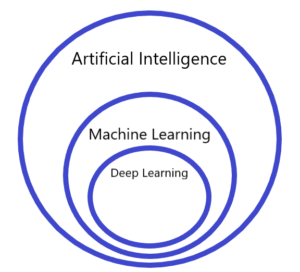Understanding the differences between Deep
Learning and Machine Learning

AI advances constantly and it’s overwhelming to stay up to date. However, if you want to keep things simple you can reduce AI innovations in pretty much two notions: machine learning and deep learning. Aren’t they the same? Sometimes we have that impression but that’s a mistake, and is vital to know the differences.
Understanding the differences between them can help you understand how Facebook recognizes faces in pictures, what drives self-driving cars (pun intended) and how Netflix determines which shows you may like. Here we’ll let you know the main differences between machine learning and deep learning.
First things first, what are they?
Actually, deep learning is a particular type of machine learning. Both are forms of AI. That means that all deep learning is machine learning but not all machine learning is deep learning. They both begin with training, test data and a model. They both pass through an optimization procedure to lead the model to fit the data. They both handle regression and classification problems.
Now that we went through their fundamental similarities, we can explain better what they are. Machine learning algorithms are divided between supervised and unsupervised. Supervised problems are also divided into classification and regression problems. Classification problems predict non-numeric answers and regression predict numeric answers.
Unsupervised learning is divided into clustering (identifying groups of similar objects), association (identifying sequences of objects), and dimensionality reduction (such as projection, and characteristics selection and extraction).
On the other hand, deep learning is a particular form of machine learning where the model has more than one hidden layer between the problem and the solution. That means that a deep learning model algorithm can determine if a prediction if accurate or not, which means it’s more advanced that basic machine learning algorithms. They are designed in such a way they analyze data through a logical structure that resembles the one of a human being.
An awesome example of deep learning is AlphaGo, from Google. The company created a program that had an engrained neural network that learned to play Go, the board game, which requires deep intuition. AlphaGo played against pro players, and the deep learning algorithm played at an unparallel level without being told how and when to make a specific move.

The differences
First of all, as we said before, deep learning is a more advanced subset of machine learning. Typical machine learning uses algorithms to analyze the data, learn from it, and make decisions based on what it learns. Deep learning, instead, organizes algorithms in different layers, a structure called “neural network” that learns and makes decisions independently. That means that even as all machine learning is AI, deep learning is the one that sustains almost all human-like AI.
That means deep learning can discover features that it needs to classify, while machine learning needs to be provided with these elements manually. In consequence, deep learning requires high-end technology and large amounts of data to deliver exact, human-resembling, results.